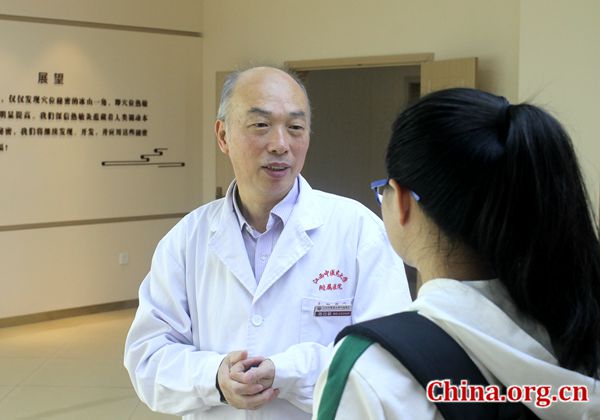TCM professor shares wonders of moxibustion
Chen Rixin, a renowned professor from the Jiangxi University of Traditional Chinese Medicine shares his decades of research on traditional Chinese medicine and moxibustion with China.org.cn in an interview in Nanchang city, Jiangxi province on Oct. 25.
"Only if given the wings of modern technology, can traditional Chinese medical treatment fly high and far," said Chen Rixin, a 63-year-old professor from the Jiangxi University of Traditional Chinese Medicine in Nanchang city, which is in south China's Jiangxi province. He revealed this when giving an interview to China.org.cn on Oct. 25. Chen has devoted himself to the teaching, research, clinical treatment and promotion of traditional Chinese medicine (TCM) for over 30 years.

In traditional Chinese medical treatment, both acupuncture and moxibustion have been used to cure diseases for over 2,000 years. Acupuncture is a kind of mechanical stimulation of the acupoints with needles while moxibustion is conducted by burning moxa either directly on the skin or above the skin's surface. However, when Chen first worked as a doctor at the affiliated hospital of the Jiangxi University of Traditional Chinese Medicine in 1986, he clearly noticed that people paid more attention to acupuncture, which had already been widely accepted, while moxibustion was only treated as a kind of thermotherapy.
Over the course of his work on moxibustion, Chen and his colleagues detected some phenomena which they found hard to explain. For example, when certain parts of the body received moxibustion, some other parts felt warm. As he consulted traditional classics on Chinese medicine like the Yellow Emperor's Canon of Internal Medicine, he learned that if a weak patient was no longer fit for acupuncture or to take medicine, the classics recommended that moxibustion be used instead. This intrigued Chen and spurred his enthusiasm to learn more about moxibustion, which he began to focus his research on in 1988.
When a person has a disease or has poor health, some related points will be heat-sensitive, Chen noted. "As moxibustion is conducted on these points, the patient can experience sensations like heat penetration, expansion or conduction, distant or deep heat reactions, as well as sensations other than heat," Chen described. "These points are called heat-sensitive acupoints." While researching heat sensitization phenomena, Chen and his team applied modern technologies like high density electroencephalograms (EEG), magnetic resonance imaging, and infrared thermal tomography to trigger heat-sensitive acupoints through moxibustion and recorded their characteristics.
After 18 years of research, the team developed the theory and technology of Heat-sensitive Moxibustion (HSM) and standardized its operation procedures. Unlike traditional moxibustion which only takes 10 to 15 minutes, HSM treatment usually takes 40 to 45 minutes to realize its full therapeutic effect, Chen emphasized. The standards of making dosage vary from person to person and completing moxibustion till disappearing of sensation were set up.
The Textbook of HSM was published by the People's Medical Publishing House in 2009, and the technology that Chen and his team developed was deemed an achievement in original innovation and won wide recognition both at home and abroad. In 2012, the team's project of infrared objective features of heat-sensitive acupoints research was authenticated and highly praised by experts. "HSM improves therapeutic effects and will play a leading role in moxibustion treatment," remarked Shi Xuemin, an academician at the Chinese Academy of Engineering. In 2014, an article entitled "Characterizing Heat-sensitization Responses in Suspended Moxibustion with High-density EEG" was published in the U.S. academic journal, Pain Medicine, and an editorial on the same journal pointed out that HSM had opened a new frontier for western medicine.
A vast amount of clinical and experimental trials have shown that HSM has curative effects on many refractory diseases, such as spinal joint diseases, allergic disorders, gastrointestinal functional disorders, male prostate diseases, female uterine syndromes, itchy skin, sub-health conditions, and syndromes resulting from radioactive treatment, Chen shared. The method is totally safe and patients always have pleasant feelings during the moxibustion process, he added while smiling.
Since 2006, Chen and his team has worked hard to promote the real world applications of HSM. It has already been used in over 500 hospitals in China and have treated 10 million patients. In 2011, the first HSM hospital was established in Nanchang and in 2015, its first overseas branch was set up in Portugal. Now there are some 100 HSM hospitals and branches in China and foreign countries, including Tunisia, Sweden, Switzerland and Uzbekistan.
In 2017, the first HSM Town was launched at Taibaozhuang, Xiashan district in Weifang city, Shandong province. A total of 63,000 people and 21,000 families in the town are now making use of HSM to cure chronic diseases or as a form of preventive therapy. "Based on the theory of Chinese medicine, patients with symptoms caused by the cold, deficiency and dampness are more commonly seen in modern times and therefore, moxibustion is an ideal means to ameliorate circulation and immunity," Chen expressed. "Many patients improved their overall heath and even came away with rosy cheeks and a better temper through the recuperative qualities of heat."
As for his future plans, Chen mentioned that he will carry on the HSM Robot R&D with a team led by Zhou Ji, an academician at the Chinese Academy of Engineering and an expert on AI manufacturing. "The HSM robot will relieve the shortage of professionals and realize long-range tele-operations," Chen expressed with confidence.
"It can also develop modelling and data accumulation to optimize treatment plans and build up a case library," Chen said. "Our mission is to let more people know about, use and benefit from HSM."

